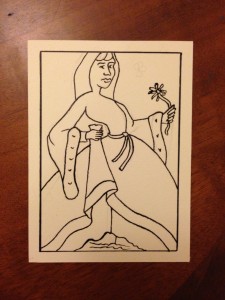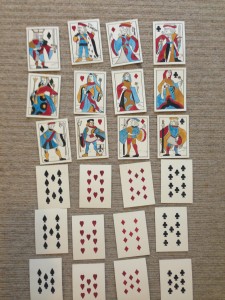|
 The last design day for the cards involved cutting blanks as for the pip cards, ruling rectangles into them, and then drawing each design. I did that in pencil and then went over it with Indian ink, to get a confident line. There were a lot of failures in the rectangles until I learned about cork-backed rulers, but then it went a lot better. Only one ink drawing failed, and I kept it as I liked the face. I intend to transform it into a vector drawing at some point. The last design day for the cards involved cutting blanks as for the pip cards, ruling rectangles into them, and then drawing each design. I did that in pencil and then went over it with Indian ink, to get a confident line. There were a lot of failures in the rectangles until I learned about cork-backed rulers, but then it went a lot better. Only one ink drawing failed, and I kept it as I liked the face. I intend to transform it into a vector drawing at some point.
I designed several cards with Fleurs de Lys, as the client wanted those in particular. Things like the garters and the boar spear were also designed to echo the shape without being explicit. Once the basic ink work was done, I let it dry for a couple of days to be sure the ink would have sunk into the surface as far as it could go, and to give myself a rest. However, the inking and the watercolouring took about half a day each, adding up to a full day.
After the ink was dry, I looked back at the Pierre Marechel deck. I had used it for the poses but the client had asked for something simpler, so I only used it for a basic idea of how colours could be abutted. I elected to use a blue that was similar to smalt, although it did not have the graininess of ground blue glass. That gives the finished cards an expensive look for the period they will be covering, to go with the client’s re-enactment persona.
 I can justify each of the processes and pigments used, either as modern swaps for old methods, or as something that was available at the time, even if it was not used by that name. Indian ink, for example, was not sold as such, but there were lamp black inks in gum Arabic. Instead of an opaque layer of card between two white layers, I had to use dark paint, to keep the thickness of the card to a minimum. As is, the deck is about twice the height of a modern deck, but this seems in keeping with the available technology, even if I used a modern stand-in. The black work would likely have been done with carved woodblocks and then the colour would go on as stencils. I did use stencils for the pips, but not for the court cards. I can justify each of the processes and pigments used, either as modern swaps for old methods, or as something that was available at the time, even if it was not used by that name. Indian ink, for example, was not sold as such, but there were lamp black inks in gum Arabic. Instead of an opaque layer of card between two white layers, I had to use dark paint, to keep the thickness of the card to a minimum. As is, the deck is about twice the height of a modern deck, but this seems in keeping with the available technology, even if I used a modern stand-in. The black work would likely have been done with carved woodblocks and then the colour would go on as stencils. I did use stencils for the pips, but not for the court cards.
If I did it again, I would screen print the cards and cut them with a guillotine, not a craft knife. Fixed knives were used for production a little later on. As is, the cards are very slightly different in shape, but they are all different enough that this is not a problem, as no particular card or suit stands out. Again, this seems to be appropriate for the era in question.
I did not give them any coating, so they are fragile to water, but the only available method would have been to rub them with dry soap, and I was unsure of the manufacturing processes of what would have been called soap at the time. It is probably tallow and lye, but it would not be entirely like modern bars.
|